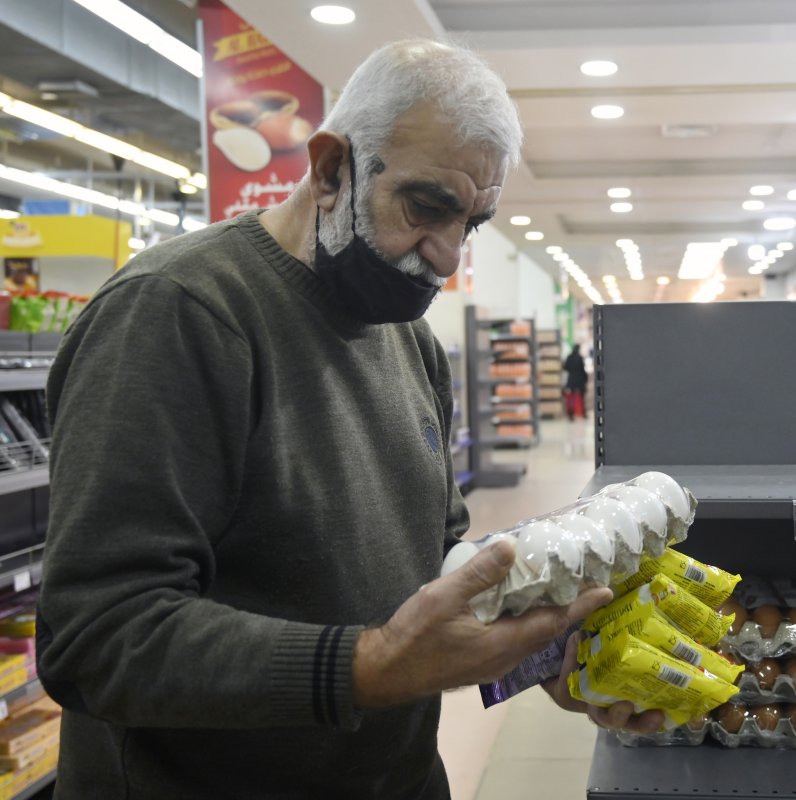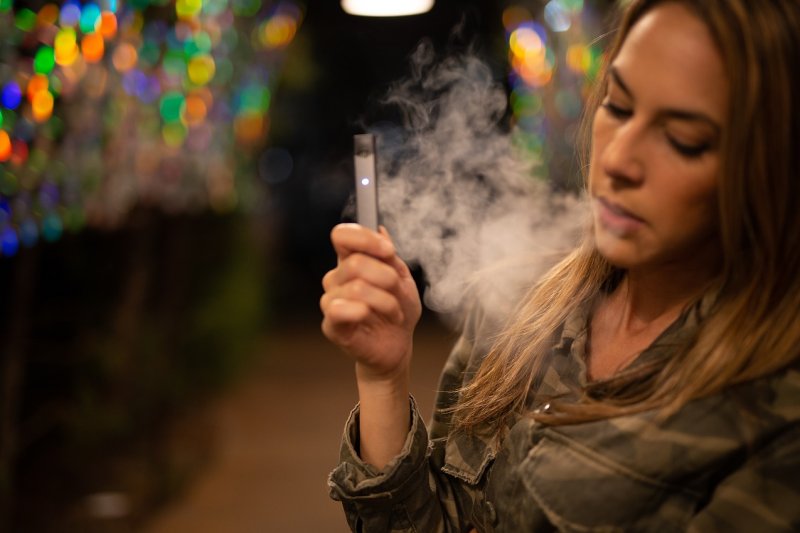
A shopper examines egg prices in a supermarket in Beirut, Lebanon. Many people are struggling to cover basic needs as food prices soar. Photo by Wael Hamzeh/EPA-EFE
BEIRUT, Lebanon, April 14 (UPI) -- Lebanon's latest economic crisis has transformed the people's once comfortable lifestyle into a struggle to secure basic needs.
Over about 45 years, the population has survived a 15-year civil war, 22 years of Israeli occupation and two major invasions, 30 years of Syrian hegemony, dozens of political assassinations and smaller economic crises, just to name a few.
But they were not prepared for today's growing poverty and unemployment, wrought by the collapse in value of the Lebanese pound, hyperinflation and a shortage of U.S. dollars.
Gone are the times when they could afford nice clothing, branded products, the latest model of cars or mobile phones, low-paid housekeepers from Ethiopia or Sri Lanka, touring restaurants and nightclubs, spending vacations abroad or holding the region's best summer festivals and cultural events.
RELATED Lebanon on brink of hunger crisis; meat is a 'luxury'
Today, putting food on the table is the ultimate priority.
More than half of the population is living below the poverty line of $3.84 dollars a day, unemployed and at risk of hunger. With the country fast running out of hard currency, people are bracing for the worst. The government can no longer sustain its food subsidy program or secure fuel for its power stations to prevent a total blackout.
Those who still have a job, but are paid in Lebanese pounds, or those who can withdraw a restricted amount of their savings blocked by the banks, are barely making ends meet. The rest are mostly living on charity and food donations distributed by local and international NGOs.
RELATED Migrant workers leave en masse, changing life for Lebanese
Only the wealthy few who smuggled their money abroad, or the lucky ones working for foreign companies and earning U.S. dollars, are able to maintain a decent living.
The Lebanese pound has lost nearly 90 percent of its value since the financial crisis broke out in October 2019, gradually dropping from a long-stabilized rate of 1,500 pound for 1 U.S. dollar to a low record of 15,000 LL last month.
Going to the supermarket has become an ordeal, with consumer prices jumping every day and people fighting over subsidized items. Even fruits and vegetables, which people used to buy by the kilo or in boxes, have become a luxury to many. Shoppers are limiting their purchase to a few pieces.
RELATED Lebanon's economic meltdown, fear of chaos push army to the edge
Food prices have increased five times since 2019, while a simple T-shirt at Zara clothing shop now costs 200,000-300,000 LL from a pre-crisis price of 45,000 LL.
"Now we realize how much everything has a value," Sabine Bustros, a mother of two and board member of the Chateau Kefraya wine producer, told UPI. "The crisis has affected my lifestyle ethically. I don't buy things the way I used to do...Many times, these were things we didn't really need."
Even though she now restricts herself to buying the basics, Bustros said she feels "ashamed" for what she can still afford while the number of people going hungry or losing their jobs has grown dramatically.
"There is so much sadness and pain...we used to take everything for granted," she said, explaining that she hasn't been to a restaurant for a year, not only because of the coronavirus restrictions but also the exorbitant bill, which would equal a worker's monthly salary of 800,000 LL.

The worsening crisis has forced people to review their priorities, dropping unnecessary spending and saving whenever possible to cover more urgent needs: medical care, education, housing and even little things like buying a new cellphone or fixing a car or refrigerator, which now costs a fortune.
As the fate of their blocked bank savings remains unknown, and no new government has been formed to open the way for a rescue program with the International Monetary Fund, they know that darkest days are ahead.
"The crisis today is a very serious one, especially after the collapse of the youth uprising of Oct. 17," said Sari Hanafi, a sociology professor at the American University of Beirut, referring to the popular non-sectarian protests that broke out in October 2019 to demand the ouster of the government and the country's corrupt political leaders. Eighteen months later, they are still in power and doing little to save the country from a total collapse.
"Lebanese have the talent of language, and some have double nationalities, so it is very easy to think of an escape gate...I mean the good talented people will leave, and this will fragilize the whole ecosystem of Lebanon," Hanafi told UPI.
Although he believes that it is not too late to introduce reforms required by the international community to rescue the country, he said the chances of a serious recovery and reshuffling the political system "is very thin."
Echoing the fears of many, he said, "Lebanon after the crisis will not be the Lebanon before the crisis...But the question is: Who will take over this new Lebanon?"
Many fear the corrupt political class will remain, and the most powerful group, the Iran-backed heavily-armed Hezbollah, would try to exploit the deterioration and impose its own vision for Lebanon, influencing its political, economic, social and cultural life.
"We will certainly reach a point where Lebanon will no longer be the country we have grown up in," Bustros said. "I doubt that we will return to the Lebanon we knew. It is over."
Despite the "unbearable situation" and the available option to live in Paris or New York, she is not willing to leave as long as she is surrounded by her family and friends of the "same education and values."
The Lebanese way of life is not just about wearing European-style clothes, mixing Arabic with French and English words in common conversations, eating out and partying, but it's also about a rich cultural life, heritage, diversity, creativity, ground-breaking private initiatives and resilience.
Nidal Ashkar, a veteran actress and founder of Al Madina Theater, doesn't want to give up on efforts to keep the theater "alive" and open to "all artists and people who still have a dream."
However, Ashkar, who has turned the theater into a space for all types of cultural activities since it was established in 1994, has reached a point where she could not pay the rent, electricity bills or her workers.
"We want to continue...for the sake of all artists who became jobless," she told UPI. "But how we will be able to do that? I really don't know."






 The Weather Network
The Weather Network
